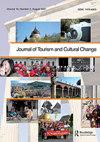社会旅游:全球挑战和方法
IF 2.5
4区 管理学
Q2 HOSPITALITY, LEISURE, SPORT & TOURISM
引用次数: 0
摘要
摘要本书分析了世界各地的社会旅游,通过实际实施的例子探索了这种旅游的理论基础。第二部分是个案研究,讨论了世界各地社会旅游概念和实施的历史演变。这一讨论还确定了在这些背景下发展社会旅游业的挑战和机遇。本书的第三部分反映了社会旅游的不同目标群体,如老年人、残疾儿童和低收入家庭的旅游体验。该书的第四部分致力于社会旅游业的实际挑战和政策含义。这本书共有13章,此外还有一个引言和一个结论。本文章由计算机程序翻译,如有差异,请以英文原文为准。
Social tourism: global challenges and approaches
Abstract
This book analyses social tourism across the world, exploring the theoretical foundations of this type of tourism with examples of practical implementations. Part II is composed of case studies discussing the historical evolution of the concept and implementation of social tourism in different parts of the world. This discussion also results in the identification of challenges and opportunities for the development of social tourism in these contexts. Part III of the book reflects on tourism experiences lived by different target groups of social tourism, such as seniors, disabled children, and low-income families. Part IV of the book is devoted to practical challenges of social tourism and policy implications. The book has 13 chapters, in addition to an introduction and a conclusion.
求助全文
通过发布文献求助,成功后即可免费获取论文全文。
去求助
来源期刊

Journal of Tourism and Cultural Change
HOSPITALITY, LEISURE, SPORT & TOURISM-
CiteScore
5.10
自引率
9.10%
发文量
31
期刊介绍:
Journal of Tourism and Cultural Change ( JTCC ) is a peer-reviewed, transdisciplinary and transnational journal. It focuses on critically examining the relationships, tensions, representations, conflicts and possibilities that exist between tourism/travel and culture/cultures in an increasingly complex global context. JTCC provides a forum for debate against the backdrop of local, regional, national and transnational understandings of identity and difference. Economic restructuring, recognitions of the cultural dimension of biodiversity and sustainable development, contests regarding the positive and negative impact of patterns of tourist behaviour on cultural diversity, and transcultural strivings - all provide an important focus for JTCC . Global capitalism, in its myriad forms engages with multiple ''ways of being'', generating new relationships, re-evaluating existing, and challenging ways of knowing and being. Tourists and the tourism industry continue to find inventive ways to commodify, transform, present/re-present and consume material culture. JTCC seeks to widen and deepen understandings of such changing relationships and stimulate critical debate by: -Adopting a multidisciplinary approach -Encouraging deep and critical approaches to policy and practice -Embracing an inclusive definition of culture -Focusing on the concept, processes and meanings of change -Encouraging trans-national/transcultural perspectives
 求助内容:
求助内容: 应助结果提醒方式:
应助结果提醒方式:


